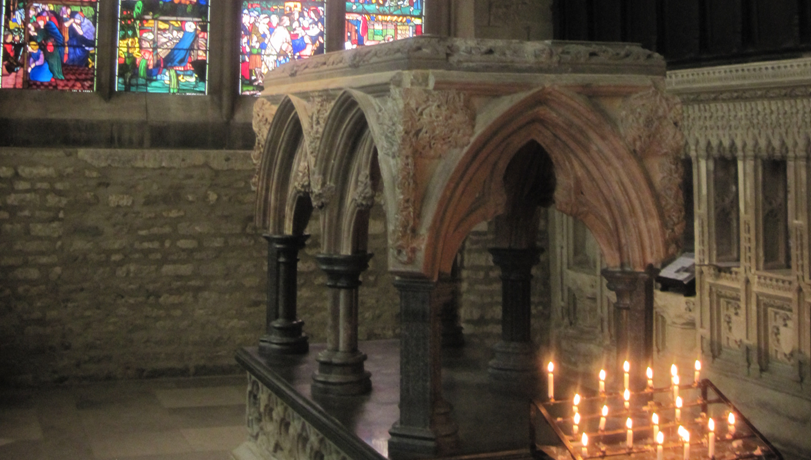 |
| St. Hugh of Lincoln on a Carthusian altarpiece in Spain. |
It was during Hugh's episcopate that he really became a saint. Hugh worked to wrestle the church out from under royal authority, reminding several kings that they were not exempt from hell, and were, in fact, well into the journey there. His humility, a relic of his Carthusian day, was a trend in Hugh's episcopate that set him apart from most other bishops of his time, challenging the behavior of the Church. King Richard one said of him "If all the bishops were like my lord of Lincoln, no prince among us could raise his head against them." He regularly visited his diocese, moving systematically from palace to palace. On his visits he established a variety of charities for the disposed and never hesitated in counselling any person who approach him whether king, child or leper. It was recorded that he enjoyed children in particular and many times ate with lepers, instead of nobles, and washed their feet, a sincere demonstration of pious humility. He had a particular affinity to the burial of the dead, so that whenever he and his episcopal retinue came across neglected dead bodies, he would would personally bury them according to the appropriate rites preformed with deep piety, or when he came into a town where there was a funeral, he would ask permission to say the Mass. While Lincoln Cathedral was being built, Hugh helped to work on the its construction by carrying a yoke to and from the work site. He also protected the Jews of his diocese in Lincoln and Oxford from popular violence. It was recorded that all the Jews participated in his funeral procession along with the 3 Archbishops, 14 bishops, 100 abbots, 3 kings and thousands of others when he died on this day in 1200.
If all the bishops of the modern Anglican Church were like St. Hugh of Lincoln, not only would all secular rulers be unable to raise their head against them, but the Church would be strong in faith and unity, and the greatest example of charity and care for human life in all the world.
Even if just a few bishops, personally worked in communities to strengthen both people's role in society and relationship to Christ and the Church, by washing people's feet, by calling the homeless to sleep inside, to visit the homes of the lonely, the elderly, the afraid ...the list does not end, the Church would be what it really is...the body of Jesus Christ, living and doing what Christ did and does.
The example of people like St. Hugh is key to the existence and mission of the Church. From his time to our time, the population for whom he showed so much Christian love had increased exponentially-and it its the Church's job to grow and do what he did-what Christ wants us to do-for all those people. The primary role of the Church is to maintain its true faith, to bring it to all people, and to treat them as Jesus would. There are other specifics, but in general it cannot afford to dwell elsewhere.
Collect:
Almighty God, who sent your servant Hugh to minister to kings and princes, children and lepers alike; to be an example of apostolic ministry for the Church and an example of Christian charity and humility for the world; grant that we, as the Church and as individuals, may minister to the world with the same penetrating humility, undaunted faith, and caring charity in the message of our Savoir Jesus Christ, Your son, who with You and the Holy Spirit, live and reign, one God, for ever and ever. Amen.
St. Hugh is often depicted with the goose that followed him around in one town in the diocese as here in stained glass from York and on a poly-chrome reredos.


.jpg)
Hugh's my man!
ReplyDeleteWonderful post....